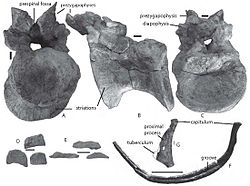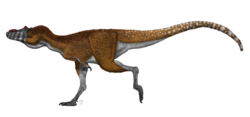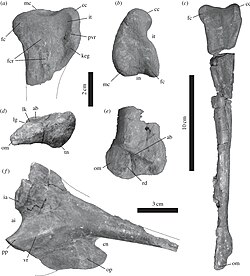| Name | Novelty | Status | Authors | Age | Unit | Location | Notes | Images |
|---|
Adelolophus [53] | Gen. et sp. nov | Valid | Gates et al. | Late Cretaceous (Campanian) | Wahweap Formation |  United States United States
| A lambeosaurine hadrosaurid. The type species is Adelolophus hutchisoni. |  |
Allosaurus lucasi [54] | Sp. nov | Disputed | Dalman | Late Jurassic (Tithonian) | Morrison Formation |  United States United States
| An allosauroid theropod, a species of Allosaurus. Study in 2020 considered this species invalid. [55] | |
Amargastegos [56] | Gen. et sp. nov | Disputed | Ulansky | Early Cretaceous (Barremian-early Aptian) | La Amarga Formation |  Argentina Argentina
| A stegosaur. The type species is Amargastegos brevicollus. According to Galton and Carpenter (2016) it did not meet the requirements of the International Code of Zoological Nomenclature. [57] | |
Andhrasaurus [56] | Gen. et. sp. nov | Disputed | Ulansky | Early Jurassic (Pliensbachian-Toarcian) | Kota Formation |  India India
| A basal thyreophoran. The type species is Andhrasaurus indicus. According to Galton and Carpenter (2016) it did not meet the requirements of the International Code of Zoological Nomenclature. [57] | |
Anzu [58] | Gen. et sp. nov | Valid | Lamanna et al. | Late Cretaceous (late Maastrichtian) | Hell Creek Formation |  United States United States
| A caenagnathid theropod. The type species is Anzu wyliei. |  |
Aquilops [59] | Gen. et sp. nov | Valid | Farke et al. | Early Cretaceous (Albian) | Cloverly Formation |  United States United States
| A basal member of Neoceratopsia. The type species is Aquilops americanus. |  |
Arcovenator [60] | Gen. et sp. nov | Valid | Tortosa et al. | Late Cretaceous (late Campanian) | |  France France
| An abelisaurid theropod. The type species is Arcovenator escotae. |  |
Camarillasaurus [61] | Gen. et sp. nov | Valid | Sánchez-Hernández & Benton | Early Cretaceous (early Barremian) | Camarillas Formation |  Spain Spain
| A theropod dinosaur; originally described as a basal ceratosaurian, but subsequently reinterpreted as a spinosaurid. [62] The type species is Camarillasaurus cirugedae. |  |
Changyuraptor [63] | Gen. et sp. nov | Valid | Han et al. | Early Cretaceous | Yixian Formation |  China China
| A microraptorine dromaeosaurid theropod. The type species is Changyuraptor yangi. |  |
Chuanqilong [64] | Gen. et sp. nov | Valid | Han et al. | Early Cretaceous (Aptian) | Jiufotang Formation |  China China
| An ankylosaurid. The type species is Chuanqilong chaoyangensis. | |
Chungkingosaurus giganticus [56] | Sp. nov | Disputed | Ulansky | Late Jurassic (Oxfordian) | Shangshaximiao Formation |  China China
| A huayangosaurid, a species of Chungkingosaurus. According to Galton and Carpenter (2016) it did not meet the requirements of the International Code of Zoological Nomenclature. [57] | |
Chungkingosaurus magnus [56] | Sp. nov | Disputed | Ulansky | Late Jurassic (Oxfordian) | Shangshaximiao Formation |  China China
| A huayangosaurid, a species of Chungkingosaurus. According to Galton and Carpenter (2016) it did not meet the requirements of the International Code of Zoological Nomenclature. [57] | |
Datanglong [65] | Gen. et sp. nov | Valid | Mo et al. | Early Cretaceous | Xinlong Formation |  China China
| A carcharodontosaur theropod. The type species is Datanglong guangxiensis. | |
Dreadnoughtus [66] | Gen. et sp. nov | Valid | Lacovara et al. | Late Cretaceous (Campanian or Maastrichtian) | Cerro Fortaleza Formation |  Argentina Argentina
| A titanosaurian sauropod. The type species is Dreadnoughtus schrani. |  |
Eoplophysis [56] | Gen. et comb. nov | Disputed | Ulansky | Middle Jurassic (Bathonian) | Cornbrash Formation |  England England
| A stegosaur; a new genus for "Omosaurus" vetustus von Huene (1910). According to Galton and Carpenter (2016) it did not meet the requirements of the International Code of Zoological Nomenclature. [57] | |
Eousdryosaurus [67] | Gen. et sp. nov | Valid | Escaso et al. | Late Jurassic | Alcobaça Formation |  Portugal Portugal
| A dryosaurid ornithopod. The type species is Eousdryosaurus nanohallucis. | |
Ferganastegos [56] | Gen. et sp. nov | Disputed | Ulansky | Middle Jurassic (Callovian) | Balabansai Formation |  Kyrgyzstan Kyrgyzstan
| A stegosaur. According to Galton and Carpenter (2016) it did not meet the requirements of the International Code of Zoological Nomenclature. [57] | |
Fosterovenator [68] | Gen. et sp. nov | Valid | Dalman | Late Jurassic (Kimmeridgian/Tithonian) | Morrison Formation |  United States United States
| A theropod dinosaur. The type species is Fosterovenator churei. |  |
Gobivenator [69] | Gen. et sp. nov | Valid | Tsuihiji et al. | Late Cretaceous (Campanian) | Djadochta Formation |  Mongolia Mongolia
| A troodontid theropod. The type species is Gobivenator mongoliensis. |  |
Gongpoquansaurus [70] | Gen. et comb. nov | Valid | You, Li & Dodson | Early Cretaceous (Albian) | Zhonggou Formation |  China China
| A non-hadrosaurid hadrosauroid; a new genus for "Probactrosaurus" mazongshanensis Lü (1997). |  |
Huangshanlong [71] | Gen. et sp. nov | Valid | Huang et al. | Middle Jurassic | Hongqin Formation |  China China
| A mamenchisaurid sauropod. The type species is Huangshanlong anhuiensis. |  |
Kulindadromeus [72] | Gen. et sp. nov | Valid | Godefroit et al. | Middle or Late Jurassic (Bajocian to Tithonian) | Ukureyskaya Formation |  Russia Russia
| A non-cerapodan neornithischian. The type species is Kulindadromeus zabaikalicus. |  |
Laquintasaura [73] | Gen. et sp. nov | Valid | Barrett et al. | Early Jurassic | La Quinta Formation |  Venezuela Venezuela
| A basal ornithischian. The type species is Laquintasaura venezuelae. |  |
Leinkupal [74] | Gen. et sp. nov | Valid | Gallina et al. | Early Cretaceous (late Berriasian to Valanginian) | Bajada Colorada Formation |  Argentina Argentina
| A diplodocine diplodocid sauropod. The type species is Leinkupal laticauda. |  |
Mercuriceratops [75] | Gen. et sp. nov | Valid | Ryan et al. | Late Cretaceous (Campanian) | Dinosaur Park Formation
Judith River Formation |  Canada Canada
 United States United States
| A chasmosaurine ceratopsid. The type species is Mercuriceratops gemini. |  |
Nanuqsaurus [76] | Gen. et sp. nov | Valid | Fiorillo & Tykoski | Late Cretaceous (Maastrichtian) | Prince Creek Formation |  United States United States
| A tyrannosaurid theropod. The type species is Nanuqsaurus hoglundi. |  |
Natronasaurus [56] | Gen. et comb. nov | Disputed | Ulansky | Late Jurassic (Kimmeridgian-Tithonian) | Morrison Formation |  United States United States
| A stegosaurid; a new genus for "Stegosaurus" longispinus Gilmore (1914). According to Galton and Carpenter (2016) it did not meet the requirements of the International Code of Zoological Nomenclature; Galton and Carpenter made "S." longispinus the type species of a new genus Alcovasaurus . [57] | |
Panguraptor [77] | Gen. et sp. nov | Valid | You et al. | Early Jurassic | Lufeng Formation |  China China
| A coelophysoid theropod. The type species is Panguraptor lufengensis. | |
Pentaceratops aquilonius [78] | Sp. nov | Valid | Longrich | Late Cretaceous (late Campanian) | Dinosaur Park Formation |  Canada Canada
| A ceratopsid, a species of Pentaceratops. |  |
Plesiohadros [79] | Gen. et sp. nov | Valid | Tsogtbaatar et al. | Late Cretaceous (probably late Campanian) | Djadochta Formation Beds of Alag Teeg |  Mongolia Mongolia
| A non-hadrosaurid hadrosauroid. The type species is Plesiohadros djadokhtaensis. | |
Qianzhousaurus [80] | Gen. et sp. nov | Valid | Lü et al. | Late Cretaceous (Maastrichtian) | |  China China
| A tyrannosaurid theropod. The type species is Qianzhousaurus sinensis. |  |
Quetecsaurus [81] | Gen. et sp. nov | Valid | González Riga & Ortiz David | Late Cretaceous (Turonian) | Cerro Lisandro Formation |  Argentina Argentina
| A titanosaur sauropod related to Mendozasaurus and Futalognkosaurus . The type species is Quetecsaurus rusconii. |  |
Rhinorex [82] | Gen. et sp. nov | Valid [83] | Gates & Scheetz | Late Cretaceous (Campanian) | Neslen Formation |  United States United States
| A saurolophine hadrosaurid. The type species is Rhinorex condrupus. |  |
Rukwatitan [84] | Gen. et sp. nov | Valid | Gorscak et al. | Cretaceous (Aptian to Cenomanian) | Galula Formation |  Tanzania Tanzania
| A titanosaur sauropod. The type species is Rukwatitan bisepultus. |  |
Saldamosaurus [56] | Gen. et sp. nov | Disputed | Ulansky | Late Jurassic | Saldam Formation |  Russia Russia
| A stegosaur. The type species is Saldamosaurus tuvensis. According to Galton and Carpenter (2016) it did not meet the requirements of the International Code of Zoological Nomenclature. [57] | |
Scelidosaurus arizonensis [56] | Sp. nov | Disputed | Ulansky | Early Jurassic (?Sinemurian-Pliensbachian) | Kayenta Formation |  United States United States
| A basal thyreophoran, a species of Scelidosaurus. According to Galton and Carpenter (2016) it did not meet the requirements of the International Code of Zoological Nomenclature. [57] | |
Siamodracon [56] | Gen. et sp. nov | Disputed | Ulansky | Late Jurassic | Phu Kradung Formation |  Thailand Thailand
| A stegosaur. The type species is Siamodracon altispinus. According to Galton and Carpenter (2016) it did not meet the requirements of the International Code of Zoological Nomenclature. [57] | |
Sinopeltosaurus [56] | Gen. et sp. nov | Disputed | Ulansky | Early Jurassic (Hettangian-Pliensbachian) | Lufeng Formation |  China China
| A basal thyreophoran. The type species is Sinopeltosaurus minimus. According to Galton and Carpenter (2016) it did not meet the requirements of the International Code of Zoological Nomenclature. [57] | |
Tachiraptor [85] | Gen. et sp. nov | Valid | Langer et al. | Earliest Jurassic | La Quinta Formation |  Venezuela Venezuela
| A stem-averostran theropod. The type species is Tachiraptor admirabilis. |  |
Tambatitanis [86] | Gen. et sp. nov | Valid | Saegusa and Ikeda | Early Cretaceous (probably early Albian) | Ohyamashimo Formation |  Japan Japan
| A titanosauriform sauropod, a member of Somphospondyli. The type species is Tambatitanis amicitiae. |  |
Torvosaurus gurneyi [87] | Sp. nov | Valid | Hendrickx & Mateus | Late Jurassic (late Kimmeridgian) | Lourinhã Formation |  Portugal Portugal
| A megalosauroid theropod, a species of Torvosaurus. |  |
Vahiny [88] | Gen. et sp. nov | Valid | Curry Rogers & Wilson | Late Cretaceous | Maevarano Formation |  Madagascar Madagascar
| A titanosaur sauropod. The type species is Vahiny depereti. | |
Wuerhosaurus mongoliensis [56] | Sp. nov. | Disputed | Ulansky | Early Cretaceous (Aptian-Albian) | Khukhtyk Formation |  Mongolia Mongolia
| A stegosaur, a species of Wuerhosaurus. According to Galton and Carpenter (2016) it did not meet the requirements of the International Code of Zoological Nomenclature. [57] | |
Yongjinglong [89] | Gen. et sp. nov | Valid | Li et al. | Early Cretaceous | Hekou Group |  China China
| A titanosaur sauropod. The type species is Yongjinglong datangi. |  |
Zaraapelta [90] | Gen. et sp. nov | Valid | Arbour, Currie & Badamgarav | Late Cretaceous | Barun Goyot Formation |  Mongolia Mongolia
| A member of Ankylosauridae. The type species is Zaraapelta nomadis. | |
Zby [91] | Gen. et sp. nov | Valid | Mateus, Mannion & Upchurch | Late Jurassic (late Kimmeridgian) | Lourinhã Formation |  Portugal Portugal
| A turiasaurian sauropod. The type species is Zby atlanticus. |  |
Zhanghenglong [92] | Gen. et sp. nov | Valid | Xing et al. | Late Cretaceous (Santonian) | Majiacun Formation |  China China
| A non-hadrosaurid hadrosauroid ornithopod. The type species is Zhanghenglong yangchengensis. |  |
Ziapelta [93] | Gen. et sp. nov | Valid | Arbour et al. | Late Cretaceous (late Campanian) | Kirtland Formation |  United States United States
| An ankylosaurid. The type species is Ziapelta sanjuanensis. |  |
|


















































